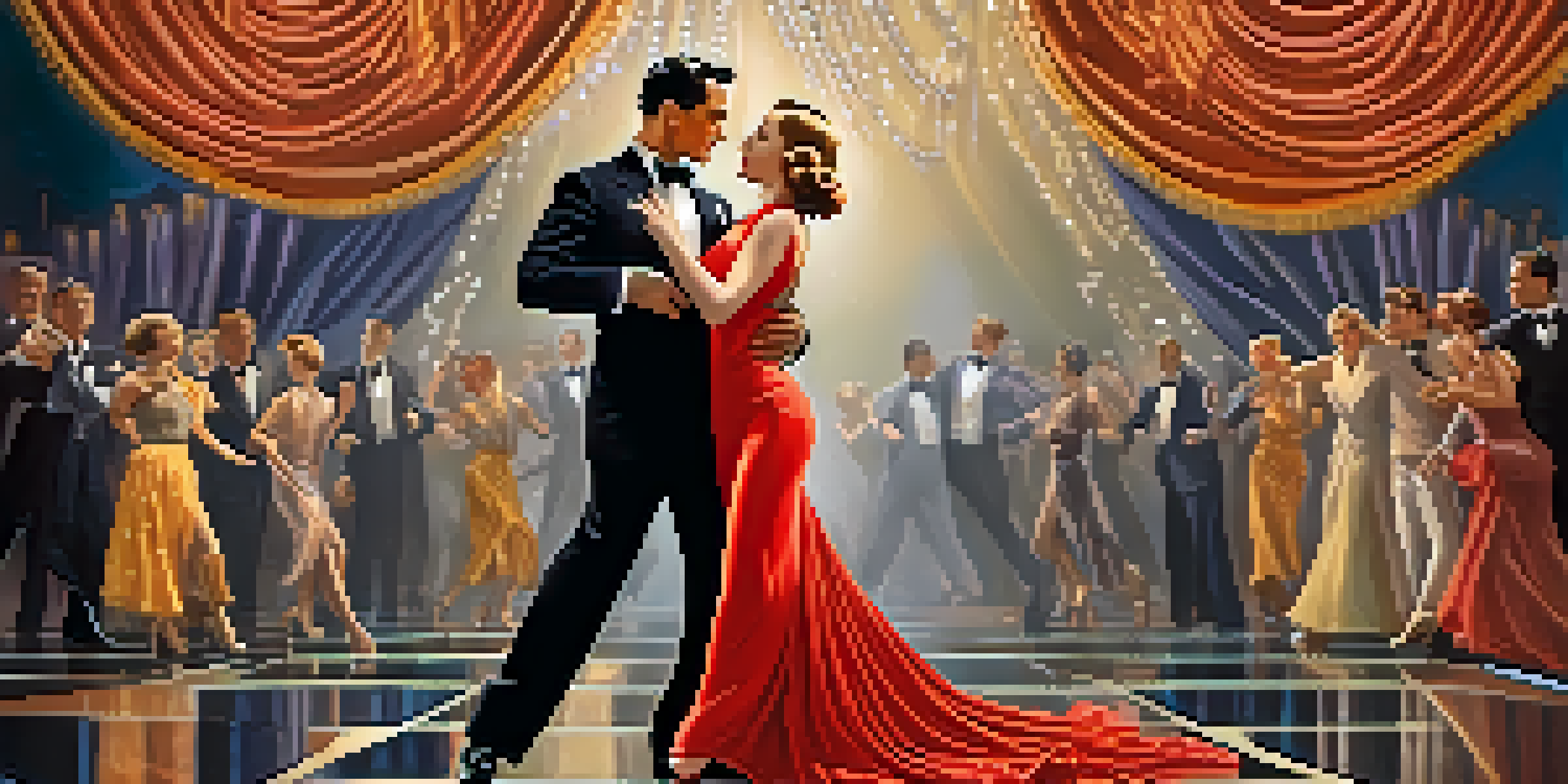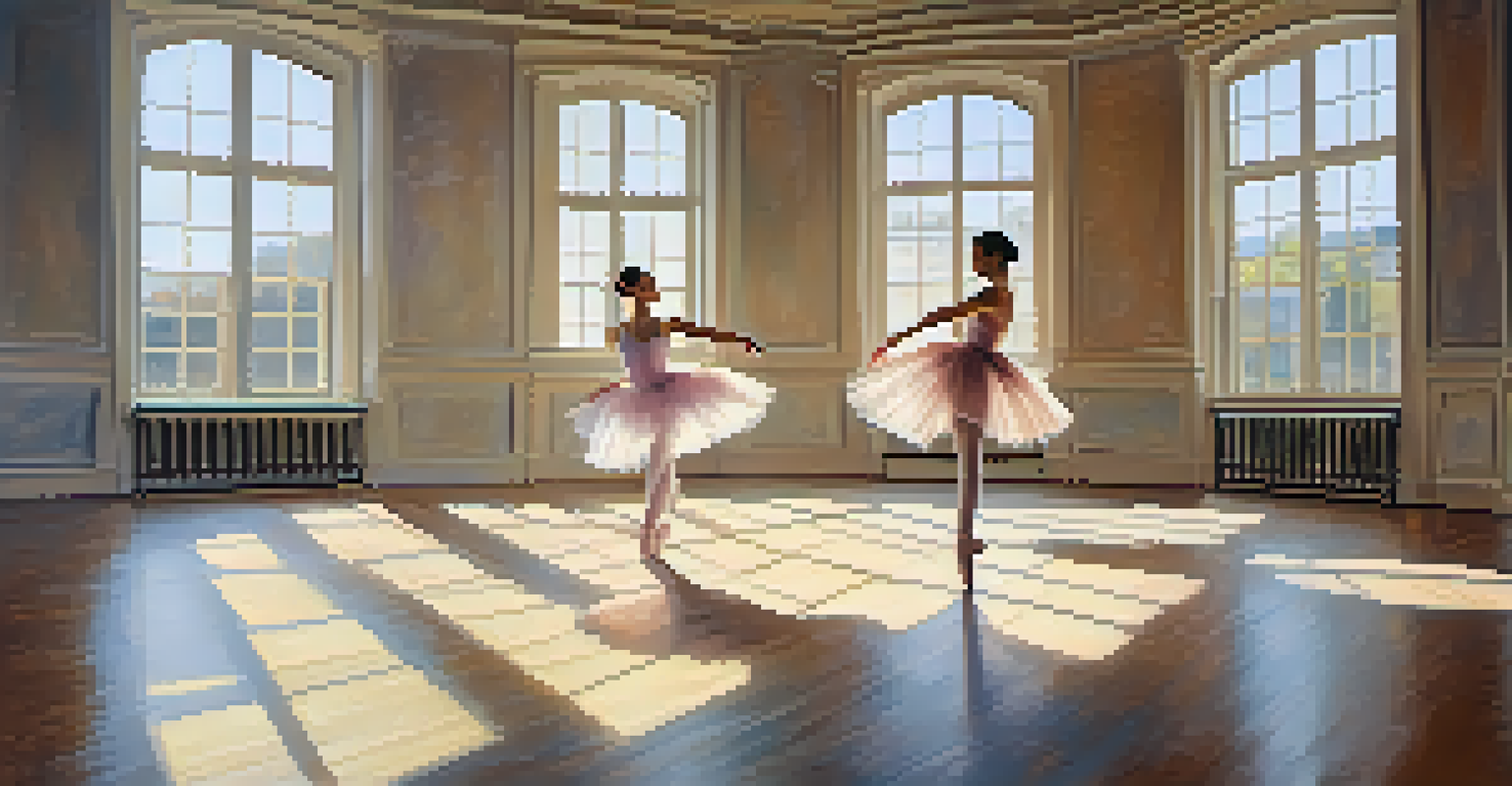The Evolution of Dance in Cinema: A Historical Perspective

The Silent Era: Dance as a Storytelling Tool
In the silent film era, dance played a crucial role in conveying emotions and narratives. With no dialogue, filmmakers relied on visual forms of expression, and dance became a vibrant storytelling device. Iconic figures like Charlie Chaplin showcased how physical movement could elicit laughter and sympathy, captivating audiences without a single spoken word.
Dance is the hidden language of the soul.
One notable example is the 1925 film 'The Phantom of the Opera,' where the ballet performance heightens the drama and tension. The expressive movements of dancers communicated the characters' inner feelings, making the silent medium come alive. This period laid the groundwork for the significance of dance in cinema, establishing it as an essential element of storytelling.
As audiences became enchanted by these early dance sequences, filmmakers recognized their potential to enhance both the emotional depth and aesthetic appeal of movies. This fascination set the stage for the evolution of dance as a central theme in cinematic narratives.
The Golden Age of Hollywood: Dance Takes Center Stage
The 1930s to the 1950s marked the Golden Age of Hollywood, where dance flourished in musical films. Stars like Fred Astaire and Ginger Rogers became household names, dazzling viewers with their impeccable choreography and chemistry. Their iconic dance numbers, such as the famous 'Cheek to Cheek' routine, highlighted the artistry and elegance of dance, elevating it to new heights.

Musicals like 'Singin' in the Rain' showcased the exuberance of dance, with elaborate sets and synchronized movements that brought joy to audiences. These films utilized dance not only to entertain but also to reflect the cultural zeitgeist of the time, often embodying themes of love, hope, and resilience.
Dance as Storytelling in Film
Throughout cinema history, dance has served as a vital storytelling tool, conveying emotions and enhancing narratives without the need for dialogue.
The choreography in these films became a character in its own right, driving the plot forward and enriching the overall cinematic experience. This era solidified the place of dance in film, proving that it could evoke powerful emotions and create unforgettable moments.
The Rise of Dance Genres: From Ballet to Hip-Hop
As cinema evolved, so did the diversity of dance styles showcased on screen. The introduction of various genres, from ballet to contemporary and even hip-hop, expanded the representation of dance in film. Movies like 'West Side Story' and 'Dirty Dancing' embraced different styles, weaving them into their narratives and reflecting the evolving cultural landscape.
The dance is a poem of which each movement is a word.
The 1980s brought a surge of interest in dance films, with movies like 'Flashdance' and 'Footloose' capturing the energy of youth culture and rebellion. These films not only popularized specific dance styles but also created a movement of their own, inspiring a generation to take dance classes and pursue their passion.
With the rise of hip-hop in the 1990s and 2000s, films like 'Step Up' and 'You Got Served' further diversified the cinematic dance landscape. These movies celebrated urban dance culture and brought it into the mainstream, showcasing the power and influence of dance across different demographics.
Dance in Modern Cinema: Blending Styles and Technologies
Today, dance in cinema has reached unprecedented levels of creativity, blending various styles and leveraging advanced technology. Directors now utilize techniques like digital effects and innovative camera angles to enhance dance sequences, creating visually stunning experiences. Films such as 'La La Land' and 'The Greatest Showman' demonstrate this fusion, showcasing breathtaking choreography alongside captivating storytelling.
Moreover, the rise of reality dance competitions has influenced modern filmmaking, with many projects incorporating elements from shows like 'So You Think You Can Dance.' These influences have led to a more diverse representation of dance styles, making contemporary films a melting pot of traditions and innovations.
Evolution of Dance Genres
From ballet to hip-hop, the diversity of dance styles in films has expanded, reflecting cultural shifts and inspiring new generations to engage with dance.
This evolution not only reflects the changing tastes of audiences but also highlights the adaptability of dance as an art form. As new styles emerge, filmmakers continue to explore and push the boundaries of what dance can achieve in cinema.
Cultural Influences: Dance as a Reflection of Society
Dance in cinema often mirrors societal changes and cultural movements, serving as a reflection of the times. For instance, the rise of feminism in the 1970s impacted dance films, leading to more empowered female characters, as seen in 'Flashdance' and 'A Chorus Line.' These films not only entertained but also challenged societal norms, encouraging women to embrace their independence and strength.
Similarly, the representation of diverse cultures in dance films has become increasingly important. Movies like 'Coco' and 'Black Panther' celebrate cultural heritage through dance, enriching the cinematic experience while promoting inclusivity and understanding.
As filmmakers recognize the power of dance to convey messages and foster connection, we see a growing trend of incorporating social issues into dance narratives. This cultural relevance makes dance in cinema not just an art form but a platform for dialogue and change.
Dance Documentaries: Celebrating the Art Form
In recent years, dance documentaries have gained popularity, offering audiences a behind-the-scenes look at the world of dance. Films like 'Twenty Feet from Stardom' and 'Dance Dreams: Hot Chocolate Nutcracker' celebrate the artistry and dedication of dancers, providing insight into their creative processes and struggles. These documentaries highlight the passion that drives dancers, making their stories relatable and inspiring.
Through interviews, performances, and personal narratives, these films illuminate the impact of dance on individuals and communities. They showcase how dance transcends mere entertainment, serving as a powerful tool for self-expression and healing.
Dance Mirrors Cultural Movements
Dance in cinema acts as a reflection of societal changes, with filmmakers increasingly incorporating themes of empowerment and inclusivity.
This genre not only honors the rich history of dance but also encourages a new generation of dancers to pursue their dreams. By documenting the lives of dancers, these films cultivate appreciation for the art form and inspire audiences to engage with dance beyond the screen.
The Future of Dance in Cinema: What Lies Ahead?
As we look to the future, the evolution of dance in cinema appears promising and dynamic. With advancements in technology, we can expect to see even more innovative approaches to choreography and storytelling. Virtual reality and augmented reality could soon allow audiences to immerse themselves in dance performances, creating interactive experiences that blur the lines between film and live performance.
Moreover, the growing influence of social media platforms like TikTok is reshaping how dance is created and consumed. New trends emerge rapidly, and filmmakers are increasingly incorporating viral dance styles into their narratives, ensuring that cinema remains relevant and connected to popular culture.

Ultimately, the future of dance in cinema will likely continue to reflect the diverse voices and experiences of society. As filmmakers embrace creativity and experimentation, we can anticipate a thrilling journey ahead, where dance remains an integral and evolving part of the cinematic experience.